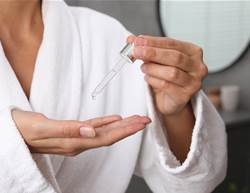Ever notice that your skin starts to feel a bit dry as winter sets in? A little tightness here, a dash of flakiness there, wistful daydreams of summer bringing effortless sweat-induced glow? There’s a good reason why it’s essential you switch up your beauty products as the mercury plummets. The conditions can be harsh out there and your skin needs more care and support.
“During winter, there are a few critical changes – the temperature drops and so does the humidity,” explains Dr Ryan De Cruz, a specialist dermatologist from Southern Dermatology in Melbourne. “In addition to that, we start wearing more layers and tweaking our environmental thermometers; the heaters or the fireplace is on, and we dry out the ambient air much more. As a result, we evaporate much more water through our skin, which really dehydrates it.”
This difficulty retaining moisture can result in dry, flaky, scaly, itchy, even irritated skin. So, how do we counteract dehydration? Dr De Cruz recommends adopting a daily skincare routine that focuses on deeply moisturising and soothing ingredients that’ll combat dryness and amp up moisture retention. He advises opting for thicker creams or balms during winter, minimising preservatives, using a soap-free cleanser to avoid stripping the skin’s surface and turning to serums and moisturisers that deliver heavy-hitting hydration.
Read on to discover some of the most effective, dermatologist-approved ingredients for skin that feels soft, hydrated and happy all winter.
Polyglutamic acid
What it does: A natural polymer and humectant, polyglutamic acid (PGA) attracts up to 5,000 times its weight in water to moisturise skin and make it look and feel more plump.
Best for: PGA is gentle and moisturising, so it’s universally beneficial for a hydration boost as needed on all skin types and in all environments, imparting a dewy look.
How to use it: It can be added into any skincare routine and doesn’t interfere with actives such as retinol. Those with dry skin can apply PGA multiple times per day. However, use sparingly on oily skin or in humid climates.
Note: Look for it in the top half of the ingredient list in products that are left on skin.
Try: Dermalogica Pro-Collagen Banking Serum, $152
Plumping, collagen preserving and deeply hydrating, this serum is formulated with jojoba ester, polyglutamic acid, amino acids and more for skin that feels soft and nourished.
Jojoba oil
What it does: Jojoba oil isn’t actually an oil, but a liquid wax that’s harvested from the seeds of the jojoba plant. This lightweight ‘liquid gold’ softens skin, lessens the appearance of wrinkles and reduces inflammation.
Best for: Jojoba oil has a composition similar to that of the skin’s natural oils, so it’s well tolerated by all skin types and won’t clog pores, yet is deeply nourishing and reparative.
How to use it: For dry skin, gently massage jojoba oil into the skin up to twice per day right after cleansing. If you have oily skin, try using it every other day or mixed with a moisturiser.
Note: Though this is rare, it has the potential to cause side effects like a rash or an allergic reaction.
Try: The Jojoba Company Australian Jojoba, from $19.95
Naturally rich in vitamins A, D and E and omegas 6 and 9, this silky, nutrient-rich jojoba leaves skin feeling nourished and hydrated.
Occlusives
What they do: This type of moisturising agent (including shea butter, petrolatum, beeswax and silicones) forms a protective surface layer to help prevent moisture loss and shield skin from irritants such as friction, cold, wind and pollen.
Best for: Due to their thick and heavy textures, occlusives are ideal solutions for dry or sensitive skin.
How to use them: They’re safe to use on dry skin multiple times per day. Alongside humectants, occlusives are found in most hydrating skincare products, from lip balm to moisturiser.
Note: Occlusives may be too rich for oily skin and can leave a sheen; some people may prefer to use them in the evening.
Try: CeraVe Advanced Repair Balm, $18
Formulated with ceramides, petrolatum and hyaluronic acid, this effective barrier cream helps accelerate the skin’s natural repair process and lock in moisture.
Ceramides
What they do: A type of naturally occurring fat, ceramides hold skin cells together to help form a healthy barrier that keeps skin hydrated.
Best for: Everyone, but particularly those with mature, dry, irritated or eczema-prone skin.
How to use them: Apply daily in a lotion or cream, either alone or following retinoids, hydroxy acids or exfoliants, to help stave off irritation and dryness.
Note: Ceramides are natural components of skin, but they get depleted with age, dryness and poor skin health. Ceramides are biologically identical to those the skin naturally produces.
Try: EGO QV Ceramides Moisturising Cream, $24
A trio of ceramides work together in this rich, hydrating moisturiser containing niacinamide and glycerin for a healthy, hydrated skin barrier.
Humectants
What it does: Humectants are water-loving ingredients, such as glycerin, hyaluronic acid, aloe and urea, that draw moisture into skin to help boost hydration.
Best for: Any skin type, but especially dry skin.
How to use it: Humectants are often formulated in moisturisers with occlusive and emollient (nourishing) ingredients. Apply them once to twice daily, morning or night.
Note: Since humectants can attract moisture from any source, in very dry environments they may dehydrate skin by absorbing water from it instead of from the air. Look for products with occlusive ingredients to seal in hydration.
Try: Summer Fridays Rich Cushion Cream Ultra Plumping Moisturizer, $89
Super hydrators glycerin, squalane and saccharide isomerate (a plant sugar-derived humectant) work alongside hyaluronic acid to moisturise dry skin.
Squalane oil
What it does: The shelf-stable version of squalene (a lipid produced by the skin’s oil glands), squalane oil closely mimics the natural molecule to hydrate, repair and protect the skin’s barrier.
Best for: It works well for any complexion, but particularly for soothing dry skin and eczema. It’s also friendly to oily skin, as it’s lightweight, non-greasy and unlikely to clog pores.
How to use it: Twice a day, after cleansing, gently massage a few drops of squalane oil into your face and follow with moisturiser.
Note: The lipid squalene has traditionally been sourced from shark livers, but many beauty brands have now shifted to plant-based sources such as rice bran, wheat germ and sugarcanes.
Try: The Ordinary 100% Plant-Derived Squalane, $17.30
This lightweight, plant-based, non-comedogenic oil locks in hydration to help prevent transepidermal water loss. The bonus? It can be used to hydrate dry hair, too.
Hyaluronic acid
What it does: A sugar molecule produced naturally by the body that’s found in skin, joints and connective tissue, this gentle humectant can attract up to 1,000 times its weight in water to hydrate, smooth and plump dry or wrinkled skin.
Best for: All skin types (allergic reactions and sensitivities are rare, as it’s naturally occurring), but hyaluronic acid is especially helpful for dry or mature skin in need of deep hydration.
How to use it: This hydrating hero is often found in products that are left on the skin, such as serums and moisturisers, and can be applied twice daily.
Note: Skin makes less natural hyaluronic acid as you age, contributing to crepiness, dryness and wrinkles. Look for ‘sodium hyaluronate’ on ingredient lists.
Try: Ella Baché Hydra Hyaluronic Cellular Serum, $109
Packed full of goodness, including three weights of hyaluronic acid, moisture-retaining polysaccharides and protective aloe vera, this fine serum is hydration in a bottle.
Want more? Read 5 Tips for the Best Winter Skin.









